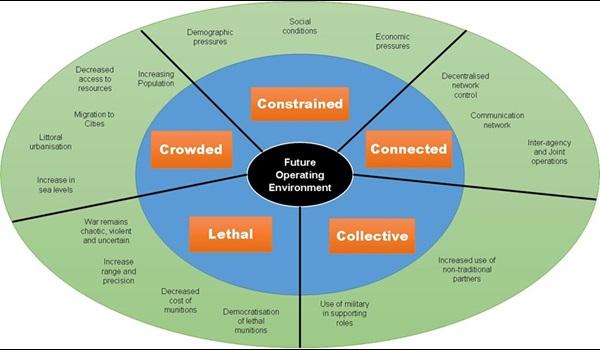As Army Officers we’re trained to respond to low probability, high impact events so maybe it’s a product of my profession or perhaps I’m a pessimistic realist. Whatever the case, I can’t help but question the underlying Western cultural bias towards the utopian future. In my view the probability of a disruptive future is actually quite high. In fact I contend that most developed nations are likely to find themselves as small islands of privilege surrounded by a sea of chaos. Perhaps not as bad as the Jerusalem Wall scene (graphic warning) from Brad Pitt’s recent zombie-fest, World War Z, yet the net result is not going to be comfortable or pretty.
I first heard the phrase “Islands of privilege in a Sea of Chaos” from a participant in the recent workshop on future concepts of warfare held in Canberra. We were exploring a number of probable scenarios that could help to define the future operating environment. These workshops and similar events always fascinate me as people generally become fixated on the technological trends as if these are the only trends that define and drive our future.
On the surface the focus on technology does make sense because, let’s face it, the scientific and technological advances we are making are incredible. For instance, light-powered nanobots will soon be small enough to enter living cells with astonishing implications for biotech. I was astounded to know that even now you can be equipped with a bionic arm pre-loaded with drones. Apparently we will soon be able to rewrite our own genome through DNA resequencing and potentially synthesise humans! Further, artificial intelligence is moving beyond our own comprehension and becoming more opaque and less visible to human users. The resulting AI and residual software may remove road fatalities through the use of self-driving trucks and drones (maybe). The ubiquitous use of trusted autonomous systems is in our very near future and will have a real impact on our society.
But to me, technology is not the driver of change, it only provides the means to drive that desired change. It amplifies and facilitates change however it requires human action and intention to actualise concepts and plans within the operating environment. On its own technology is simply silicon, plastic and code. It is the innately competitive nature of humans, operating in an era of dwindling resources that will shape our future. Thus relying on the advancement of technology as an accurate predictor of our future ignores other, more significant drivers Here are three of the most glaringly obvious drivers:
- Climate change – The World Economic Forum’s Global Risks Report 2016 identifies “the failure of climate change mitigation and adaptation” as the most consequential risk for the years to come, as well as one of the most likely drivers of change. Food and water crises and large-scale involuntary migration are presented as closely and intricately linked risk events. Global warming will both amplify the consequences and complicate existing patterns of cooperation and competition amongst global and regional actors.
- Demographics – According to a UN report (pdf) the world population is expected to reach 9.7 billion by 2050, with 5.2 billion urban dwellers. Of these the less developed regions of the world are projected to have 82 per cent of the world’s urban population and 86 per cent of the total world population. Not only will the urban centres of these less developed regions absorb most of the growth in urban population, they will also absorb most of the growth in the entire world population
- Economic change – It appears that the economic centre of gravity is shifting from West to East, and North to South. Global growth is projected at 3.5% per annum, leading to increasing numbers of people from Asia, and to lesser extent, Africa and South America transitioning from poverty into middle income classes. However it is expected that there will be an increasing range of inequalities between and within states
Fortunately, we have not been oblivious to these trends. Both the Vice Chief of Defence Force (VCDF) Group and the Australian Army have recognised these in two foundational documents, the soon to be released Future Operating Environment and the Future Land Warfare Report 2014 (FLWR14).
The FLWR14 hypothesised that the future conflict environment will be characterised by five mega-trends:
- Crowded Environment characterised by increasing population, massive migration to cities, decreased access to resources, littoral urbanisation and increase in sea levels.
- Connected Environment characterised by increased in global communication capability, decentralised control of networks and increased use of inter-agency and joint operations.
- Lethal Environment characterised by increased lethality of available weapon systems; increased capacity for precise and discriminating targeting at distance; increase in range, accuracy and target-end effect of munitions; continuing use of fragmentation, anti-armour and anti-aircraft munitions; decreasing cost of munitions; and increase in range and sensitivity of detection systems.
- Collective Environment characterised by increase in use of militaries in security and stabilisation operations; increase in use of joint, combined, coalition and inter-agency operations; and increasing collective action with non-traditional partners including non-government organisations, host nations governments, indigenous security forces, sanctioned representatives of corporations and non-state security forces.
- Constrained Environment characterised by continuing constraints imposed by Australia’s economic, demographic and social environments.
This seemingly chaotic operational environment really should not surprise us. We have the knowledge and we have forewarned ourselves. Therefore, if we wished to avoid the dystopian future for the preferred utopia, how should we design the force to operate in this environment?
If my postulated future is too grim for you and you believe cultural inertia will prevent a planned response in favour of a more reactive one, the good news for you is that there are plenty more planets out there and NASA is working on deep-sleep chambers and magnetic force fields.





